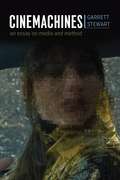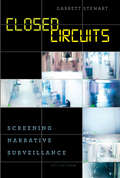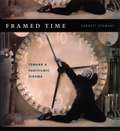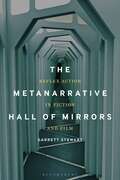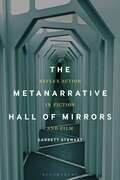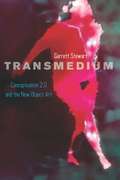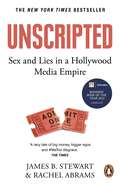- Table View
- List View
Cinemachines: An Essay on Media and Method
by Garrett StewartThe hero stands on stage in high-definition 3-D while doubled on a crude pixel screen in Billy Lynn’s Long Halftime Walk. Alien ships leave Earth by dissolving at the conclusion of Arrival. An illusory death spiral in Vertigo transitions abruptly to a studio set, jolting the spectator. These are a few of the startling visual moments that Garrett Stewart examines in Cinemachines, a compelling, powerful, and witty book about the cultural and mechanical apparatuses that underlie modern cinema. Engaging in fresh ways with revelatory special effects in the history of cinematic storytelling—from Buster Keaton’s breaching of the film screen in Sherlock Jr. to the pixel disintegration of a remotely projected hologram in Blade Runner 2049—Stewart’s book puts unprecedented emphasis on technique in moving image narrative. Complicating and revising the discourse on historical screen processes, Cinemachines will be crucial reading for anyone interested in the evolution of the movies from a celluloid to a digital medium.
Cinemachines: An Essay on Media and Method
by Garrett StewartThe hero stands on stage in high-definition 3-D while doubled on a crude pixel screen in Billy Lynn’s Long Halftime Walk. Alien ships leave Earth by dissolving at the conclusion of Arrival. An illusory death spiral in Vertigo transitions abruptly to a studio set, jolting the spectator. These are a few of the startling visual moments that Garrett Stewart examines in Cinemachines, a compelling, powerful, and witty book about the cultural and mechanical apparatuses that underlie modern cinema. Engaging in fresh ways with revelatory special effects in the history of cinematic storytelling—from Buster Keaton’s breaching of the film screen in Sherlock Jr. to the pixel disintegration of a remotely projected hologram in Blade Runner 2049—Stewart’s book puts unprecedented emphasis on technique in moving image narrative. Complicating and revising the discourse on historical screen processes, Cinemachines will be crucial reading for anyone interested in the evolution of the movies from a celluloid to a digital medium.
Cinemachines: An Essay on Media and Method
by Garrett StewartThe hero stands on stage in high-definition 3-D while doubled on a crude pixel screen in Billy Lynn’s Long Halftime Walk. Alien ships leave Earth by dissolving at the conclusion of Arrival. An illusory death spiral in Vertigo transitions abruptly to a studio set, jolting the spectator. These are a few of the startling visual moments that Garrett Stewart examines in Cinemachines, a compelling, powerful, and witty book about the cultural and mechanical apparatuses that underlie modern cinema. Engaging in fresh ways with revelatory special effects in the history of cinematic storytelling—from Buster Keaton’s breaching of the film screen in Sherlock Jr. to the pixel disintegration of a remotely projected hologram in Blade Runner 2049—Stewart’s book puts unprecedented emphasis on technique in moving image narrative. Complicating and revising the discourse on historical screen processes, Cinemachines will be crucial reading for anyone interested in the evolution of the movies from a celluloid to a digital medium.
Cinemachines: An Essay on Media and Method
by Garrett StewartThe hero stands on stage in high-definition 3-D while doubled on a crude pixel screen in Billy Lynn’s Long Halftime Walk. Alien ships leave Earth by dissolving at the conclusion of Arrival. An illusory death spiral in Vertigo transitions abruptly to a studio set, jolting the spectator. These are a few of the startling visual moments that Garrett Stewart examines in Cinemachines, a compelling, powerful, and witty book about the cultural and mechanical apparatuses that underlie modern cinema. Engaging in fresh ways with revelatory special effects in the history of cinematic storytelling—from Buster Keaton’s breaching of the film screen in Sherlock Jr. to the pixel disintegration of a remotely projected hologram in Blade Runner 2049—Stewart’s book puts unprecedented emphasis on technique in moving image narrative. Complicating and revising the discourse on historical screen processes, Cinemachines will be crucial reading for anyone interested in the evolution of the movies from a celluloid to a digital medium.
Cinemachines: An Essay on Media and Method
by Garrett StewartThe hero stands on stage in high-definition 3-D while doubled on a crude pixel screen in Billy Lynn’s Long Halftime Walk. Alien ships leave Earth by dissolving at the conclusion of Arrival. An illusory death spiral in Vertigo transitions abruptly to a studio set, jolting the spectator. These are a few of the startling visual moments that Garrett Stewart examines in Cinemachines, a compelling, powerful, and witty book about the cultural and mechanical apparatuses that underlie modern cinema. Engaging in fresh ways with revelatory special effects in the history of cinematic storytelling—from Buster Keaton’s breaching of the film screen in Sherlock Jr. to the pixel disintegration of a remotely projected hologram in Blade Runner 2049—Stewart’s book puts unprecedented emphasis on technique in moving image narrative. Complicating and revising the discourse on historical screen processes, Cinemachines will be crucial reading for anyone interested in the evolution of the movies from a celluloid to a digital medium.
Closed Circuits: Screening Narrative Surveillance
by Garrett StewartThe recent uproar over NSA dataveillance can obscure the fact that surveillance has been part of our lives for decades. And cinema has long been aware of its power—and potential for abuse. In Closed Circuits, Garrett Stewart analyzes a broad spectrum of films, from M and Rear Window through The Conversation to Déjà Vu, Source Code, and The Bourne Legacy, in which cinema has articulated—and performed—the drama of inspection’s unreturned look. While mainstays of the thriller, both the act and the technology of surveillance, Stewart argues, speak to something more foundational in the very work of cinema. The shared axis of montage and espionage—with editing designed to draw us in and make us forget the omnipresence of the narrative camera—extends to larger questions about the politics of an oversight regime that is increasingly remote and robotic. To such a global technopticon, one telltale response is a proliferating mode of digitally enhanced “surveillancinema.”
Closed Circuits: Screening Narrative Surveillance
by Garrett StewartThe recent uproar over NSA dataveillance can obscure the fact that surveillance has been part of our lives for decades. And cinema has long been aware of its power—and potential for abuse. In Closed Circuits, Garrett Stewart analyzes a broad spectrum of films, from M and Rear Window through The Conversation to Déjà Vu, Source Code, and The Bourne Legacy, in which cinema has articulated—and performed—the drama of inspection’s unreturned look. While mainstays of the thriller, both the act and the technology of surveillance, Stewart argues, speak to something more foundational in the very work of cinema. The shared axis of montage and espionage—with editing designed to draw us in and make us forget the omnipresence of the narrative camera—extends to larger questions about the politics of an oversight regime that is increasingly remote and robotic. To such a global technopticon, one telltale response is a proliferating mode of digitally enhanced “surveillancinema.”
Closed Circuits: Screening Narrative Surveillance
by Garrett StewartThe recent uproar over NSA dataveillance can obscure the fact that surveillance has been part of our lives for decades. And cinema has long been aware of its power—and potential for abuse. In Closed Circuits, Garrett Stewart analyzes a broad spectrum of films, from M and Rear Window through The Conversation to Déjà Vu, Source Code, and The Bourne Legacy, in which cinema has articulated—and performed—the drama of inspection’s unreturned look. While mainstays of the thriller, both the act and the technology of surveillance, Stewart argues, speak to something more foundational in the very work of cinema. The shared axis of montage and espionage—with editing designed to draw us in and make us forget the omnipresence of the narrative camera—extends to larger questions about the politics of an oversight regime that is increasingly remote and robotic. To such a global technopticon, one telltale response is a proliferating mode of digitally enhanced “surveillancinema.”
Closed Circuits: Screening Narrative Surveillance
by Garrett StewartThe recent uproar over NSA dataveillance can obscure the fact that surveillance has been part of our lives for decades. And cinema has long been aware of its power—and potential for abuse. In Closed Circuits, Garrett Stewart analyzes a broad spectrum of films, from M and Rear Window through The Conversation to Déjà Vu, Source Code, and The Bourne Legacy, in which cinema has articulated—and performed—the drama of inspection’s unreturned look. While mainstays of the thriller, both the act and the technology of surveillance, Stewart argues, speak to something more foundational in the very work of cinema. The shared axis of montage and espionage—with editing designed to draw us in and make us forget the omnipresence of the narrative camera—extends to larger questions about the politics of an oversight regime that is increasingly remote and robotic. To such a global technopticon, one telltale response is a proliferating mode of digitally enhanced “surveillancinema.”
Closed Circuits: Screening Narrative Surveillance
by Garrett StewartThe recent uproar over NSA dataveillance can obscure the fact that surveillance has been part of our lives for decades. And cinema has long been aware of its power—and potential for abuse. In Closed Circuits, Garrett Stewart analyzes a broad spectrum of films, from M and Rear Window through The Conversation to Déjà Vu, Source Code, and The Bourne Legacy, in which cinema has articulated—and performed—the drama of inspection’s unreturned look. While mainstays of the thriller, both the act and the technology of surveillance, Stewart argues, speak to something more foundational in the very work of cinema. The shared axis of montage and espionage—with editing designed to draw us in and make us forget the omnipresence of the narrative camera—extends to larger questions about the politics of an oversight regime that is increasingly remote and robotic. To such a global technopticon, one telltale response is a proliferating mode of digitally enhanced “surveillancinema.”
Closed Circuits: Screening Narrative Surveillance
by Garrett StewartThe recent uproar over NSA dataveillance can obscure the fact that surveillance has been part of our lives for decades. And cinema has long been aware of its power—and potential for abuse. In Closed Circuits, Garrett Stewart analyzes a broad spectrum of films, from M and Rear Window through The Conversation to Déjà Vu, Source Code, and The Bourne Legacy, in which cinema has articulated—and performed—the drama of inspection’s unreturned look. While mainstays of the thriller, both the act and the technology of surveillance, Stewart argues, speak to something more foundational in the very work of cinema. The shared axis of montage and espionage—with editing designed to draw us in and make us forget the omnipresence of the narrative camera—extends to larger questions about the politics of an oversight regime that is increasingly remote and robotic. To such a global technopticon, one telltale response is a proliferating mode of digitally enhanced “surveillancinema.”
Framed Time: Toward a Postfilmic Cinema (Cinema and Modernity)
by Garrett StewartItalian director Michelangelo Antonioni claimed, three decades ago, that different conceptions of time helped define the split in film between European humanism and American science fiction. And as Garrett Stewart argues here, this transatlantic division has persisted since cinema’s 1995 centenary, made more complex by the digital technology that has detached movies from their dependence on the sequential frames of the celluloid strip. Brilliantly interpreting dozens of recent films—from Being John Malkovich, Donnie Darko, and The Sixth Sense to La mala educación and Caché —Stewart investigates how their treatments of time reflect the change in media from film’s original rolling reel to today’s digital pixel. He goes on to show—with 140 stills—how American and European narratives confront this shift differently: while Hollywood movies tend to revolve around ghostly afterlives, psychotic doubles, or violent time travel, their European counterparts more often feature second sight, erotic telepathy, or spectral memory. Stewart questions why these recent plots, in exploring temporality, gravitate toward either supernatural or uncanny apparitions rather than themes of digital simulation. In doing so, he provocatively continues the project he began with Between Film and Screen, breaking new ground in visual studies, cinema history, and media theory.
Framed Time: Toward a Postfilmic Cinema (Cinema and Modernity)
by Garrett StewartItalian director Michelangelo Antonioni claimed, three decades ago, that different conceptions of time helped define the split in film between European humanism and American science fiction. And as Garrett Stewart argues here, this transatlantic division has persisted since cinema’s 1995 centenary, made more complex by the digital technology that has detached movies from their dependence on the sequential frames of the celluloid strip. Brilliantly interpreting dozens of recent films—from Being John Malkovich, Donnie Darko, and The Sixth Sense to La mala educación and Caché —Stewart investigates how their treatments of time reflect the change in media from film’s original rolling reel to today’s digital pixel. He goes on to show—with 140 stills—how American and European narratives confront this shift differently: while Hollywood movies tend to revolve around ghostly afterlives, psychotic doubles, or violent time travel, their European counterparts more often feature second sight, erotic telepathy, or spectral memory. Stewart questions why these recent plots, in exploring temporality, gravitate toward either supernatural or uncanny apparitions rather than themes of digital simulation. In doing so, he provocatively continues the project he began with Between Film and Screen, breaking new ground in visual studies, cinema history, and media theory.
Framed Time: Toward a Postfilmic Cinema (Cinema and Modernity)
by Garrett StewartItalian director Michelangelo Antonioni claimed, three decades ago, that different conceptions of time helped define the split in film between European humanism and American science fiction. And as Garrett Stewart argues here, this transatlantic division has persisted since cinema’s 1995 centenary, made more complex by the digital technology that has detached movies from their dependence on the sequential frames of the celluloid strip. Brilliantly interpreting dozens of recent films—from Being John Malkovich, Donnie Darko, and The Sixth Sense to La mala educación and Caché —Stewart investigates how their treatments of time reflect the change in media from film’s original rolling reel to today’s digital pixel. He goes on to show—with 140 stills—how American and European narratives confront this shift differently: while Hollywood movies tend to revolve around ghostly afterlives, psychotic doubles, or violent time travel, their European counterparts more often feature second sight, erotic telepathy, or spectral memory. Stewart questions why these recent plots, in exploring temporality, gravitate toward either supernatural or uncanny apparitions rather than themes of digital simulation. In doing so, he provocatively continues the project he began with Between Film and Screen, breaking new ground in visual studies, cinema history, and media theory.
The Metanarrative Hall of Mirrors: Reflex Action in Fiction and Film
by Garrett StewartWith its laser-focus on the verbal and visual infrastructure of narrative, The Metanarrative Hall of Mirrors is the first sustained comparative study of how image patterns are tracked in prose and cinema. In film examples ranging from Citizen Kane through Apocalypse Now to Blade Runner 2049, then on to Christopher Nolan's 2020 Tenet, Garrett Stewart follows the shift from celluloid to digital cinema through various narrative manifestations of the image, from freeze-frames to computer-generated special effects. By bringing cinema alongside literature, Stewart discovers a common tendency in contemporary storytelling, in both prose and visual narrative, from the ongoing trend of “mind-game” films to the often puzzling narrative eccentricities of such different writers as Nicholson Baker and Richard Powers-including the latter's eerie mirroring of reader empathy in his 2021 Bewilderment.
The Metanarrative Hall of Mirrors: Reflex Action in Fiction and Film
by Garrett StewartWith its laser-focus on the verbal and visual infrastructure of narrative, The Metanarrative Hall of Mirrors is the first sustained comparative study of how image patterns are tracked in prose and cinema. In film examples ranging from Citizen Kane through Apocalypse Now to Blade Runner 2049, then on to Christopher Nolan's 2020 Tenet, Garrett Stewart follows the shift from celluloid to digital cinema through various narrative manifestations of the image, from freeze-frames to computer-generated special effects. By bringing cinema alongside literature, Stewart discovers a common tendency in contemporary storytelling, in both prose and visual narrative, from the ongoing trend of “mind-game” films to the often puzzling narrative eccentricities of such different writers as Nicholson Baker and Richard Powers-including the latter's eerie mirroring of reader empathy in his 2021 Bewilderment.
Transmedium: Conceptualism 2.0 and the New Object Art
by Garrett StewartIf you attend a contemporary art exhibition today, you’re unlikely to see much traditional painting or sculpture. Indeed, artists today are preoccupied with what happens when you leave behind assumptions about particular media—such as painting, or woodcuts—and instead focus on collisions between them, and the new forms and ideas that those collisions generate. Garrett Stewart in Transmedium dubs this new approach Conceptualism 2.0, an allusion in part to the computer images that are so often addressed by these works. A successor to 1960s Conceptualism, which posited that a material medium was unnecessary to the making of art, Conceptualism 2.0 features artworks that are transmedial, that place the aesthetic experience itself deliberately at the boundary between often incommensurable media. The result, Stewart shows, is art whose forced convergences break open new possibilities that are wholly surprising, intellectually enlightening, and often uncanny.
Transmedium: Conceptualism 2.0 and the New Object Art
by Garrett StewartIf you attend a contemporary art exhibition today, you’re unlikely to see much traditional painting or sculpture. Indeed, artists today are preoccupied with what happens when you leave behind assumptions about particular media—such as painting, or woodcuts—and instead focus on collisions between them, and the new forms and ideas that those collisions generate. Garrett Stewart in Transmedium dubs this new approach Conceptualism 2.0, an allusion in part to the computer images that are so often addressed by these works. A successor to 1960s Conceptualism, which posited that a material medium was unnecessary to the making of art, Conceptualism 2.0 features artworks that are transmedial, that place the aesthetic experience itself deliberately at the boundary between often incommensurable media. The result, Stewart shows, is art whose forced convergences break open new possibilities that are wholly surprising, intellectually enlightening, and often uncanny.
Transmedium: Conceptualism 2.0 and the New Object Art
by Garrett StewartIf you attend a contemporary art exhibition today, you’re unlikely to see much traditional painting or sculpture. Indeed, artists today are preoccupied with what happens when you leave behind assumptions about particular media—such as painting, or woodcuts—and instead focus on collisions between them, and the new forms and ideas that those collisions generate. Garrett Stewart in Transmedium dubs this new approach Conceptualism 2.0, an allusion in part to the computer images that are so often addressed by these works. A successor to 1960s Conceptualism, which posited that a material medium was unnecessary to the making of art, Conceptualism 2.0 features artworks that are transmedial, that place the aesthetic experience itself deliberately at the boundary between often incommensurable media. The result, Stewart shows, is art whose forced convergences break open new possibilities that are wholly surprising, intellectually enlightening, and often uncanny.
Transmedium: Conceptualism 2.0 and the New Object Art
by Garrett StewartIf you attend a contemporary art exhibition today, you’re unlikely to see much traditional painting or sculpture. Indeed, artists today are preoccupied with what happens when you leave behind assumptions about particular media—such as painting, or woodcuts—and instead focus on collisions between them, and the new forms and ideas that those collisions generate. Garrett Stewart in Transmedium dubs this new approach Conceptualism 2.0, an allusion in part to the computer images that are so often addressed by these works. A successor to 1960s Conceptualism, which posited that a material medium was unnecessary to the making of art, Conceptualism 2.0 features artworks that are transmedial, that place the aesthetic experience itself deliberately at the boundary between often incommensurable media. The result, Stewart shows, is art whose forced convergences break open new possibilities that are wholly surprising, intellectually enlightening, and often uncanny.
Transmedium: Conceptualism 2.0 and the New Object Art
by Garrett StewartIf you attend a contemporary art exhibition today, you’re unlikely to see much traditional painting or sculpture. Indeed, artists today are preoccupied with what happens when you leave behind assumptions about particular media—such as painting, or woodcuts—and instead focus on collisions between them, and the new forms and ideas that those collisions generate. Garrett Stewart in Transmedium dubs this new approach Conceptualism 2.0, an allusion in part to the computer images that are so often addressed by these works. A successor to 1960s Conceptualism, which posited that a material medium was unnecessary to the making of art, Conceptualism 2.0 features artworks that are transmedial, that place the aesthetic experience itself deliberately at the boundary between often incommensurable media. The result, Stewart shows, is art whose forced convergences break open new possibilities that are wholly surprising, intellectually enlightening, and often uncanny.
Transmedium: Conceptualism 2.0 and the New Object Art
by Garrett StewartIf you attend a contemporary art exhibition today, you’re unlikely to see much traditional painting or sculpture. Indeed, artists today are preoccupied with what happens when you leave behind assumptions about particular media—such as painting, or woodcuts—and instead focus on collisions between them, and the new forms and ideas that those collisions generate. Garrett Stewart in Transmedium dubs this new approach Conceptualism 2.0, an allusion in part to the computer images that are so often addressed by these works. A successor to 1960s Conceptualism, which posited that a material medium was unnecessary to the making of art, Conceptualism 2.0 features artworks that are transmedial, that place the aesthetic experience itself deliberately at the boundary between often incommensurable media. The result, Stewart shows, is art whose forced convergences break open new possibilities that are wholly surprising, intellectually enlightening, and often uncanny.
The Ways of the Word: Episodes in Verbal Attention
by Garrett StewartIn The Ways of the Word, Garrett Stewart steps aside from theory to focus on the sheer pleasure of attentive reading and the excitement of recognizing the play of syllables and words upon which the best literary writing is founded. Emerging out of teaching creative writing and a broader effort to convene writers and critics, Stewart's "episodes in verbal attention" track the means to meaning through the byways of literary wording.Through close engagement with literary passages and poetic instances whose imaginative demands are their own reward, Stewart gathers exhibits from dozens of authors: from Dickinson, Dickens, and DeLillo to Whitman, Woolf, and Colson Whitehead. In the process, idiom, tense, etymology, and other elements of expressive language and its phonetic wordplay are estranged and heard anew. The Ways of the Word fluidly and intuitively reveals a verbal alchemy that is as riveting as it is elusive and mysterious.
Unscripted: The Epic Battle for a Hollywood Media Empire
by James B. Stewart Rachel Abrams'Explosive' Esquire 'Epic' Financial Times 'Riveting' Vanity FairSumner Redstone was the CEO of Hollywood's most influential company: the powerhouse behind Indiana Jones and Star Wars, film studios and TV production companies, a fleet of private jets and tailor-made jewellery lines. He was notorious for his fearsome temper, his all-consuming ambition and his pledge to live forever. Until, one day, he lost control.Unscripted is the story of an empire embroiled in scandal, a will in tatters, and a family on the edge of self-destruction. It sounds too outrageous to be true - except it is.Longlisted for the Financial Times Business Book of the Year Award'A racy tale of big money, bigger egos and #MeToo disgrace.' The Times'Addicted to Succession? Well, here's the real thing.' Hollywood Reporter
The Story of British Animation (British Screen Stories)
by Jez StewartJez Stewart charts the course of this extraordinarily fertile area of British film from early experiments with stop-motion and the flourishing of animated drawings during WWI. He reveals how the rockier interwar period set the shape of the industry in enduring ways, and how creatives like Len Lye and Lotte Reiniger brought art to advertising and sponsored films, building a foundation for such distinctive talents as Bob Godfrey, Alison De Vere and George Dunning to unleash their independent visions in the age of commercial TV. Stewart highlights the integral role of women in the industry, the crucial boost delivered by the arrival of Channel 4, the emergence of online animation and much more. The book features 'close-up' analyses of key animators such as Lancelot Speed and Richard Williams, as well as more thematic takes on art, politics and music. It builds a framework for better appreciating Britain's landmark contributions to the art of animation, including Halas and Batchelor's Animal Farm (1954), Dunning's Yellow Submarine (1968) and the creations of Aardman Animations.
